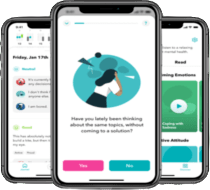Neck pain treatment online | Online Physiotherapy Clinic
- Affordable and reliable neck pain treatment
- Video sessions with expert Physiotherapists/ PTs.
- Specialized physical therapy for neck pain, sprain, bursitis, or stiffness
Begin Therapy
Consult online with best Physios
A New Model for Neck Pain Treatment
We understand that it’s difficult for most of us to find time for traditional Neck physical therapy. Physio Mantra brings to you online Neck pain treatment, where all neck exercises and treatments are managed through regular online check-ins & video sessions.
Expert Physical therapists
Physio Mantra members get matched with a professional physiotherapist for one-on-one Neck pain treatment. They use interactive exercise videos available on our app to treat you.
Continuous Medical Care
Physio Mantra physiotherapists are 100% virtual and provide physical therapy to patients without any time and geographical barriers. Our technology-enabled approach helps manage physical ailments from head to toe.
Personalized Neck Pain therapy
Physio Mantra provides everyday exercises, home remedies, and regular check-ins for all your Neck pain physiotherapy needs. We individualize treatment for each person, with problems including Neck pain, muscle injuries, sprain, bursitis, stiffness, and more.

Best Neck Pain Clinic, Now In Your Pocket
Our physical therapists or PTs are available in all parts of the world via an easy-to-use mobile application. The use of artificial intelligence, and data science enables the patients to connect with expert physiotherapists and get real-time insights into their Neck health. Download PhysioMantra App Now

How it works

Signup for our Neck Treatment Program
Just fill up a 5-minute online form to tell us about your neck pain history and treatment expectations.

Meet your PT
We will connect you with a physiotherapist who is available 24/7 to you via call or chat.

Connect to our app
Get Physical Therapy sessions on our app via video calls. Follow exercises suggested by our PT and track your progress in the app.
Meet the best online physical therapist
MantraCare physical therapists treat muscle and joint pain problems through a combination of body exercises, video demonstrations, and a healthy diet. Our treatment experience is a better traditional in-person approach in multiple ways.

Dedicated Physio
You get a personal Physio who customizes the exercise plan based on your comfort and needs

App-guided Exercises
3D animations & voice narrations in our app ensure proper and right guidance

Expert care anywhere, anytime
With over 200+ physios, MantraCare is 100% online – no waiting rooms

Exercise Kit
Complete exercise kit with elastic bands, door anchor, and a phone stand – mailed to you
A Complete Guide On Neck Pain Physiotherapy
Understanding neck pain
Neck pain is one of the most common complaints and is often caused by overuse, stress, or injury. Neck pain can be mild to severe and may go away without any treatment, but if it lasts more than a few days it should not be ignored.
Symptoms of neck pain include stiffness in the neck muscles and difficulty moving your head from side to side or up and down. You may also feel tenderness around the base of your skull where it meets your upper spine (cervical) vertebrae.
If left untreated for long periods of time these symptoms can progress into numbness, tingling sensations throughout arms fingers; loss of control strength with hands due to constant pressure on nerve fibers running through the cervical area causing them to become compressed pinched leading to chronic conditions such as carpal tunnel syndrome.
Types of Neck Pain
There are many types of neck pain and they can be caused by a variety of reasons. Some of these types are:
Muscle Pain
Muscle tension or spasm is the most common type of neck pain. This can be caused by stress, poor posture, overuse, or injury. The muscles in your neck may become tight and tender, and you may have difficulty moving your head from side to side or up and down.
Muscle Spasm
This type of pain is often felt on one side of the neck and can cause stiffness in the muscles around your shoulder blade (scapula) or upper arm. This may be due to stress from sitting at a computer all day long, poor posture while sleeping not getting enough restful sleep habits;
Muscle Strain
This is when a person’s muscles are strained due to overuse such as sitting at an office desk for long periods of time without getting up every now then taking breaks – stretches.
Muscle Weakness
This type of pain is usually felt in the shoulders and upper back and can be caused by poor posture or stress from sitting at a computer all day long. You may also feel stiff when you try to lift something heavy like groceries bags full of water bottles etcetera;
Nerve Pain (Cervical Radiculopathy)
The nerves that run through your neck may become pinched or squeezed due to bone spurs on vertebrae herniated discs osteoarthritis degenerative disc disease (DDD). This causes numbness tingling sensations throughout arms fingers; loss of control strength with hands due to constant pressure on nerve fibers running through the cervical area.
Signs of Neck Pain
There are many signs of neck pain, but some of the most common are:
Stiffness
This is often felt in the muscles around your shoulder blade (scapula) or upper arm. You may also feel stiff when you try to lift something heavy like groceries bags full of water bottles etcetera;
Muscle weakness
This type of sign is usually felt in the shoulders and upper back and can be caused by poor posture or stress from sitting at a computer all day long.
Tingling Sensation
Tingling sensations are often a sign of nerve compression and may be felt in your fingers, hands, arms, or shoulders.
Numbness
This is also a common symptom of nerve compression and may feel like you’re “wearing a glove” or that your hand or arm is asleep.
Pain
The type and severity of pain can vary depending on the cause of your neck pain. It may be sharp and stabbing, dull and aching, or throbbing. You may also experience referred pain – which is pain that’s felt in another area of the body such as the shoulders, upper back, or head.
Causes of Neck Pain
There are many causes of neck pain, some of which are:
Injury or Trauma
This is often due to an accident such as a fall from a bicycle or skateboard, a car crash, a sports injury. This can also be the result of overuse when playing football basketball hockey other contact sports games where colliding with another player causes trauma pressure on cervical area vertebrae discs resulting in chronic conditions like whiplash syndrome.
Poor Posture
The muscles around your neck may become tight tender due to stress poor posture while sitting at a computer all day long not getting enough restful sleep habits;
Overuse from Playing Sports
This is often seen with athletes who play football basketball hockey other contact sports games were colliding with another player causes trauma pressure on cervical area vertebrae discs resulting in chronic conditions like whiplash syndrome.
Osteoarthritis
This is a degenerative joint disease that affects the cartilage and bones within a joint. It can cause pain, stiffness, and swelling within the affected joint – which is often the neck.
Smoking
There is a link between smoking and an increased risk of developing neck pain. This may be due to nicotine’s effects on the body’s ability to heal damaged tissues or because smokers are more likely to have poor posture.
Treatment Options For Neck Pain
There are many treatment options for neck pain. Some of the most common include:
Over-the-Counter Medication
This is often a first-line treatment option for mild to moderate cases of neck pain and stiffness.
Prescription Medications
These are usually used in more severe cases, or if over-the-counter medications haven’t helped ease symptoms. There are many different types including opioids which can cause side effects like drowsiness constipation nausea vomiting headache dizziness dry mouth difficulty urinating (if taken long term).
Physical Therapy
Physical therapy is often recommended for neck pain. It can help to improve range of motion reduce inflammation and pain strengthen muscles around the neck and improve posture.
Chiropractic Care
Chiropractic care is a treatment option that focuses on realigning the spine using spinal manipulation therapy (SMT). This may help to relieve tension in the muscles surrounding the neck and improve joint function.
Surgery
This is usually only considered as a last resort if other treatments haven’t helped, and there’s evidence that surgery will provide relief from symptoms. Surgery options include cervical fusion which fuses two or more vertebrae together eliminating movement between them or disc replacement surgery where a damaged disc is removed and replaced with an artificial one.
Physiotherapy For Neck Pain
Physiotherapy is one of the most popular and effective treatments for neck pain. A physiotherapist will assess your condition and create a treatment plan that is tailored to your specific needs. It may include exercises, stretches, and massage.
This treatment also includes lifestyle advice, such as:
- Ways to maintain a good posture while walking and sitting
- How to avoid activities that may contribute to the pain
Types of Physiotherapy For Neck Pain
There are many types of physiotherapy treatments for neck pain, including:
Manual Therapy
It can include mobilization and manipulation. Manual therapy is used to ease the tension in your muscles. This also helps in improving movement and function.
Neck Exercises
Physiotherapists suggest neck exercises to ease the pain and stiffness. They can also help you prevent future injuries by strengthening your muscles. Here are a few common types of neck exercises:
- Stretches – It will help you relieve nerve compression, muscle tension, and stiffness in the back of your head. Some stretches include chin tucks, side-bending stretch, and ear-to-shoulder stretch
- Strengthening – This helps build up endurance for supporting your head on top of your shoulders at various angles throughout the day
Electrotherapy
This is a treatment that uses electricity to stimulate nerve endings or muscle contractions. There are many types of electrotherapies, such as ultrasound, laser therapy, and interferential currents (IFC). Each type has its benefits depending on the cause of your neck pain.
Exercises
Physiotherapists will teach you exercises that target specific areas of your body so that they become stronger over time. These exercises may be aerobic (cardiovascular) or strengthening-based ones. They can also improve posture, range of motion (ROM), and flexibility.
Posture Education
Physiotherapists will teach you how to sit properly while working at a desk or driving your car. They may also suggest exercises that can strengthen muscles in your neck area so they become less prone to injury or strain when you are performing daily tasks like lifting heavy objects or carrying groceries home from the store.
Benefits of Physiotherapy For Neck Pain
There are many benefits of physiotherapy for neck pain. Some of these include:
Improving the strength and flexibility of your muscles
- Helping you maintain an upright posture
- Reducing inflammation caused by arthritis or other conditions that affect joints in your body like osteoarthritis (OA) or rheumatoid arthritis (RA).
- This can also help relieve pain associated with those conditions as well.
- Makes you more aware of the proper way to perform tasks such as carrying groceries or lifting objects at work. It can reduce strain on your neck muscles and joints which reduces the risk for injury over time.
10,000+ Happy Wrist Pain patients from the world

“After years of struggling with neck pain, I finally decided to go see a physiotherapist. Within just a few visits my neck was feeling so much better! The pain was gone, and my range of motion was restored. I NEVER thought that physiotherapist care could help me in this way.”
Kamya, 3 Months at MantraCare
Best physiotherapist from across the world





We treat nearly all muscle and joint issues
Not all physical or muscle problems are the same. Different types of problems require different treatments. At MantraCare, 200+ physical therapist the world cover a range of specialties to meet your needs be it back pain, shoulder pain, or sports injury:
Frequently Asked Questions
Physiotherapists will often give you exercises to do at home on your own, but some treatments such as manual therapy and electrotherapy may require a visit to the clinic. This will depend on your specific condition and treatment plan.
This will vary depending on your individual situation. Some people may only require a few sessions, while others may need ongoing treatment for several months or even years. Your physiotherapist will be able to give you an estimate based on your specific condition.
Wear loose clothing that allows the therapist to access the area that is being treated. For example, if you are having manual therapy done on your neck, it is best to wear a tank top or T-shirt.
This depends on the cause of your neck pain and how severe it is. You may need just a few sessions or more depending on your condition.
Some insurance companies may cover part or all of the cost of physiotherapy treatment, so it’s best to check with them directly. It may also be possible to get funding from your provincial health plan if you are having trouble paying for the treatment.
Physiotherapists can help treat many types of conditions that cause neck pain, including arthritis and muscle strains or sprains. It’s best to talk with a professional about how they can assist you in relieving your symptoms so as not to make them worse over time.
It depends on your condition and what type of treatment plan you are following with the physiotherapist, but there are many different stretches that can be done from sitting positions such as neck rolls or shoulder blade squeezes just to name a few!
This varies person-to-person so please discuss this question with your doctor during an appointment before beginning any type of physical therapy program because they will need specific information related specifically to their needs in order to determine how long it will likely take them to achieve relief from pain symptoms associated with neck disorders such as cervical spondylosis (neck arthritis) or cervical radiculopathy (pinched nerves).
It depends on your condition and what type of therapy program you are following, but there are many different stretches that can be done from sitting positions such as neck rolls or shoulder blade squeezes just to name a few! The answer is mostly yes though because these exercises will improve blood circulation in the area which means more oxygenated blood flowing through those muscles during rest periods at night so they stay healthy throughout day-to-day activities.











